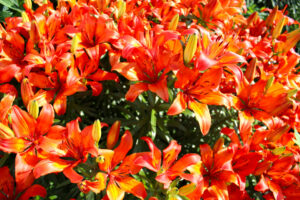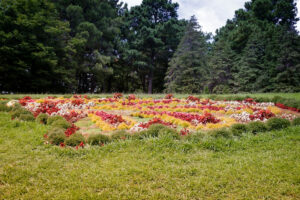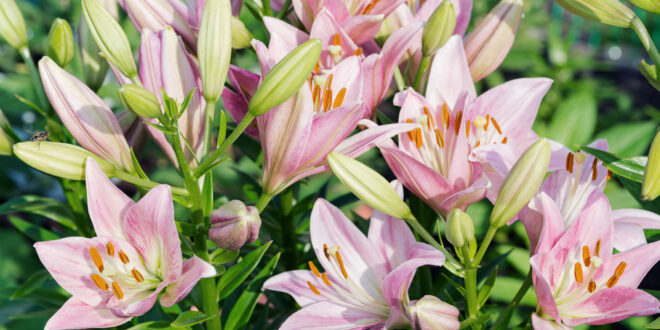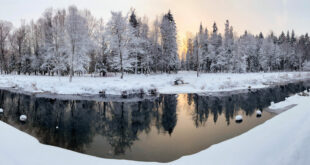Have you ever visited a botanical garden? Have you viewed the manicured lawns, the trimmed bushes, the carefully tended flowers, and the pools with vegetation in them? One such garden included these beauties in their long list of flowers for July and August: Blackeyed Susan ‘Goldsturm”, Crapemyrtle, Evergreen wisteria, Flame acanthus, ‘Gold Star’ esperanza ‘Gold Star,’ Hardy blue plumbago, Hyacinth bean, Mexican Oregano, Purple coneflower, Spider lily Lycoris, Surprise lilies Lycoris, Sweet autumn clematis, Sweet potato vine, Trumpet vine, and Crimson trumpet. As you visit one or several of these gardens, you cannot help but be amazed at God’s creative handywork.
Jesus loved flowers and talked about them. Can you imagine the beauty of the Garden of Eden with the trees, the fruit, and the flowers (the 3rd and 6th day of creation, Genesis 1:11-12, 29-31)? There were no weeds and no disease-carrying insects. Everything was perfect. He created them in all their beauty and glory. God said it was “VERY GOOD.” Jesus said, concerning the lilies, that Solomon, in all his glory, was not arrayed like one of these.
Lilies come in a wide array of colors. They can be white (symbolizing purity), pink (femininity, grace), yellow (happiness, positivity), orange (passion, creativity), Red (love, passion), and purple (royalty, luxury). There are also some rarer colors, such as black, blue, green, and brown.

Some scholars believe that the lilies of Christ’s time in Israel were scarlet marathons, a type of lily that came into bloom when Jesus spoke about them. Because of its beautiful color and abundance, it was a superb illustration for Jesus’ teaching.
A few years ago, botanists discovered the oldest fossilized lily – estimated to be about 115 million years old. Surprisingly, to evolutionists, it looked just like the lily of today. It must have forgotten to evolve. To the evolutionist, it was evidence that there were already diverse kinds of lilies 115 million years ago. But this was not a surprise to creationists.
Off the coast of Australia, deep-sea researchers for the Deep Down Under project used a remotely operated vehicle (ROV) to explore the depths. The ROV imaged a living sea lily off Queensland’s coast around Osprey Reef. It was exactly like the fossils of sea lilies preserved from the Cambrian and other geologic layers. The estimated time span for the Cambrian layer is about 485 to 541 million years ago. Why did these sea lilies fail to evolve over a half billion years?
Botany focuses on the study of plants. “Lilies are classified as perfect, complete, monocot flowers. A perfect flower contains both the stamen (male reproductive part) and the carpel (female reproductive parts) in the same flower. An imperfect flower only has one of the reproductive structures. Lilies are complete flowers because they have sepals, petals, pistils, and stamens.” There are about 100 different species of lilies, but they all share common features. Most lilies have six petals arranged in a star-like pattern. God created these flowers in all their complexity. When He completed creation, He declared it all “very good.” (Genesis 1:31).

Lilies are magnificent in appearance, but they have many uses besides decoration, bouquets, and arrangements. Creative businesses use lilies in perfumes, soaps, cosmetics, stress relieving tea, homemade facial masks, potpourris, and other purposes.
Why did Jesus use the lily for his illustration? In Matthew 6:28-29 Jesus said, “And why take ye thought for raiment? Consider the lilies of the field, how they grow; they toil not, neither do they spin: And yet I say unto you, That even Solomon in all his glory was not arrayed like one of these.” Jesus said that if God can clothe the lilies, grass, and things of nature that will quickly wither and pass away, can He not take care of you? Flowers and vegetation are temporary. God is eternal. God takes care of these transitory living things. How much more will he take care of you?
Remember the stories of God’s provision and protection throughout the Scriptures. Remember God’s provision of manna and water in the wilderness; God’s protection with phenomenal military victories through Joshua; God’s feeding of Elijah in the wilderness and the feeding of the widow of Zarephath (1 Kings 17); the feeding of the 5000 and then the 4,000 by Christ; and God’s promise to faithful believers in 2 Corinthians 9:6-8.
As beautiful as flowers and all of nature are, human beings are much more important than any part or item of nature. People are so significant to God that His Son gave His life to ransom us from the ravages, desolation, and ultimate punishment of sin. “For God so loved the world, that he gave his only begotten Son, that whosoever believeth in him should not perish, but have everlasting life. For God sent not his Son into the world to condemn the world; but that the world through him might be saved. He that believeth on him is not condemned: but he that believeth not is condemned already, because he hath not believed in the name of the only begotten Son of God.” (John 3:16-18)
Peter wrote, “For all flesh is as grass, and all the glory of man as the flower of grass. The grass withereth, and the flower thereof falleth away: But the word of the Lord endureth for ever. And this is the word which by the gospel is preached unto you.” (1 Peter 1:24-25).
Grass, flowers, and vegetation are all beautiful and are God’s provision, but they are all temporary. His Word endures forever. God keeps, honors, and fulfills His Word and every promise given.
God’s provision for us exceeds His provision for lilies, all flowers, and animal life. We can trust Him. His provision for us physically and spiritually through His eternal Word and power surpasses any promise or provision made by man.
Trust Him!
 The Bottom Line, Ministries Christian News, Articles, & Poetry
The Bottom Line, Ministries Christian News, Articles, & Poetry 





WHAT A GREAT ARTICLE